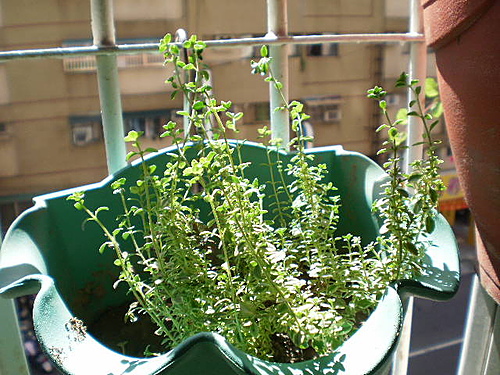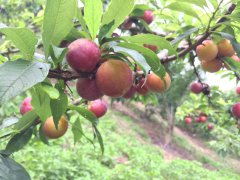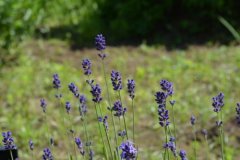When is thyme planted and in what season is it pruned? What is the effect and function of thyme?
In the past, I didn't know at all what thyme was. As I was fond of cooking food, I often went shopping at the baking material store. I inadvertently saw that a pile of seasoned bottles and cans would face me when I didn't buy them home. I had seen all the seasonings I had heard and packed them back to my home. I took them out and used them when I wanted to cook them, and so far there are still a lot of unsent on the stage. What are the breeding methods and matters needing attention of thyme?
At the beginning of this year! Unintentionally, I began to plant vanilla plants, which could be planted from March to August before I came into contact with fresh thyme (before I only knew how to use powdered thyme powder). I fell in love with it at a glance. I don't know how many pots were dead. As long as my eyes saw it all the time, I must buy it home all the time. I was disappointed, very difficult to serve, warm and cool and needed to keep dry. I was a layman in gardening. I really suffered a lot. It was like burning money. I bought a pot to practice kung fu in a few days. Now it can be said that planting is a good season. Never buy it and plant it in summer. It will be difficult with the money. If you trim it, you can judge it according to its growth. In the past, I only knew to plant it well, but I didn't want to take care of it, but I cut it off at any time to make the material, so as not to hang up again.
Thyme "thumos" in English means "fragrance", which evolved from Greek and means "to have courage" and "to worship the gods". At that time, praising a man for his courage can be said to have the smell of thyme. In cooking, thyme is called a "mixer", which means that it can pull the taste of food together, which may be because its taste is mild but not very exciting. Thyme's name is due to the Greek goddess Venus who wept sadly when she witnessed the heavy casualties of the Trojan War. When tears fall into the world, they are transformed into "thyme." there is a legend in ancient Greece that a young girl in Sichun as long as she embroidered a pattern of thyme on her clothes, or planted a thyme on her body, meant to find a lover and wait for the suitor to show her love. Shy man, drink a cup of thyme tea, I heard that can muster up the courage to pursue the love. A 16th century bard called the aroma of thyme a "dawn paradise" because it smelled fresh and charming, natural and comfortable, and as pure and beautiful as heaven.
"Thyme" is cold-resistant, drought-resistant and has strong vitality; the plant is about 15-30 cm tall, with dark green to dark turquoise leaves, small pink or white flowers, and strong fragrance of stems, leaves and flowers. Pick a few leaves and gently rub them in your hands to give off a faint fragrance, fragrant temperature and pleasant. Thyme is less resistant to moisture and should avoid stagnant water when there is too much rain in summer, because it needs so much light that it will grow too much even under a transparent canopy. It is best to be cultivated in the open field, planted on south or east slopes to avoid stagnant water and plenty of sunshine. The soil should not be too fertile. It is planted on the gravel ground. Although it grows slowly, it is easier to survive the rainy season. In medieval times, thyme had another special function. People who attended funerals usually wore fresh thyme, so that they would not be infected by the sadness of others, and they would not fall into an atmosphere of sadness and become strong. Therefore, the Greeks also like to burn thyme leaves to incense the environment, the smell of thyme can make people happy, increase self-confidence and firm will. Ancient witches dried thyme leaves and filled them in pillows to drive away nightmares.
The vanilla plant thyme is a kind of vanilla with strong bactericidal power. the harvested lemon thyme can make tea to relieve the symptoms of colds, can also do cooking, but also can boost the spirit and eliminate fatigue. It can be regarded as an omnipotent vanilla plant. The ancient Egyptians used it for embalming, and because thyme can corrupt organic matter and promote bile secretion, drinking thyme juice after dinner helps digestion, and thyme is also a sacrifice to Venus and other gods. The Romans cooked with thyme and used it medicinally, and the Romans believed that thyme could ward off sadness and inspire courage. In the Middle Ages, thyme was used to treat plague and paralysis, leprosy and body lice, and thyme was also used in the king's bouquet to prevent infection in public, which shows that people's respect for thyme has not diminished, even during World War I. thyme and clove, lemon and chamomile essential oils are all disinfectants and antimicrobials in hospitals.
Thyme rich in thymol (thymol) is a natural fungicide and preservative, which is widely used in various antitussive and expectorant medicines, throat syrup, syrup, mouthwash, toothpaste or various topical ointment for anti-inflammation and relieving itching. In the days when there was no refrigerator, cured meat often added thyme to take its antibacterial and antiseptic function, but also to add aroma. And according to traditional Chinese medicine, thyme is pungent, slightly warm, and has the effect of warming and dispelling cold, expelling wind and relieving pain. the whole grass is used as medicine, and when the branches and leaves are luxuriant in summer, the whole plant is uprooted, washed, cut off the root (which can be cultivated and propagated), cut, fresh or dried. Can be used for vomiting, abdominal pain, diarrhea, food less ruffian distension, wind-cold cough, swollen throat, toothache, body pain, skin itching. Studies around the world have shown that thymol contained in thyme has a germicidal effect on throat, mouth and respiratory tract, which is conducive to protecting respiratory tract, preventing colds, and cleaning nasal mucosa; it also has the effect of eliminating fatigue, refreshing spirit and restoring physical strength. can be used to relieve alcohol and eliminate hangovers, calm nerves, relieve insomnia; but also promote blood circulation, ease the cold hands and feet.

- Prev

The most common varieties of plums, Hongyu plum / white plum / yellow meat plum, are introduced and the characteristics of Taian plum are introduced.
When it comes to Miaoli Taian, we have to mention plums, bamboo shoots, ginger and hot springs! Today, the editor came to Yunyi Farm 800 meters above sea level to visit Brother Li Shiqing, who specializes in growing plums. Li's family began to grow plums from Brother Li's grandfather, and Brother Li began to grow plums from his father's hands.
- Next

Hybrid lavender varieties: what are the differences between hybrid lavender and head lavender
Do you like lavender? This is a kind of plant used to make essential oil, which is very popular with consumers. There is a big difference between lavender and sage. Do you want to know the characteristics of panicle lavender and head lavender? Let's have a look! Panicle flower fumigation
Related
- The first cup of black tea in spring, the flavor and history of tea gardens in Kenya, Africa
- The computer can not only choose potatoes, but also grow tea rice. AI will grow winter oolong tea champion.
- It is not only the inflated tea bitten by insects, but also engraved with the four seasons tea in Beipu.
- The Oriental Beauty Tea Festival in Zhuxian County takes the stage at the weekend to experience the plus-size feast of oil tea.
- & quot; Oriental Beauty Tea & Exploration of Emei in Hsinchu, the hometown of quot;
- The new variety of strawberry "Tainong 1" dessert is the first choice with mellow aroma. Crimson gorgeous
- History of Tea in Taiwan: from Wild Inner Mountain to Export Tea Garden
- Two types of Taiwan Oriental Beauty Black Tea won the British three-Star Award for Childhood Tea Xiang Zhang Jiaqi changed from pilot to champion tea maker.
- Banana species and varieties: the planting history of Taiwan Xianren banana and dwarf banana is long, is banana disease resistant?
- Coffee planting Technology: Qianjie Coffee from Seedling to harvesting

